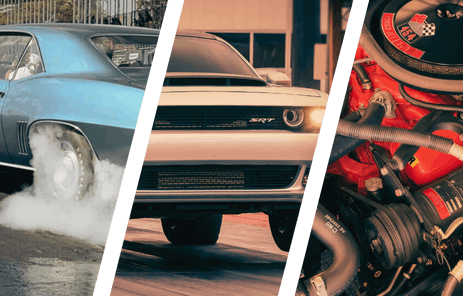The hot rod scene today is a culmination of breakthrough technology, societal culture, and the film industry. Let’s discuss some pivotal points in American history that have shaped kustoms and the community that surrounds it.
Acquiring The Opportunity
Whether it is seen as the lust for speed or unique modification or fabrication, hot rodding has grown into its own entity with time. The 1930s laid down the foundation of hot rodding, with the forming of the Southern California Timing Association (SCTA). The SCTA helped bring car clubs and speed shops together at its inception, which had 23 clubs by 1938. Despite setbacks from the war, there was a strong enough community to hold meets, form clubs, hoist trophies, and showcase fast cars.
The 1930s also brought about the development of fiberglass, which led to many companies experimenting with the lightweight material. In 1938, the company Owens-Corning was formed, and by the time World War II began, they discovered that heat-treating the cloth made the material useful when reinforcing plastic laminates.
While fiberglass cloth was being developed, DuPont patented polyester resin. By the end of 1942, Owens-Corning was fabricating fiberglass aircraft parts for the war. Soldiers returning home from the war, after having acquired the skills to fabricate or wrench were looking for ways to use their new skills. Searching for an outlet to eradicate the horrors of war, and those feeling the adrenaline from high speed flight, and mobility in aircraft, craved for more.
The Pivotal 50s

According to one of our previous articles, Zora Arkus Duntov, considered by many to be the father of the Corvette, wrote a letter titled, “Thoughts Pertaining to Youth, Hot Rodders, and Chevrolet.” This three-page letter was sent to Chevrolet’s management team, asking Chevy to make performance parts available to hot rodders, who were currently using flathead Fords, surging the popularity of the then new small-block Chevy mill.
Chevy’s small-block engine changed the world of hot rodding in several ways since IndyCar racing involved exotic cars that no one could afford nor relate to with their huge sedans and station wagons.
The Fuel Ban And Search For More Speed
Due to safety concerns, the NHRA banned the use of nitromethane during competition in 1957. The smells, speeds, and sounds the nitro created caused an outcry by fans who attended the events.
Gas-powered dragsters were running mid ten second times at 140mph at the beginning of the fuel ban, but nitro-powered competitors could hit seven second times at 190mph speeds all day. Thinking outside of the box, some racers attempted to build multi-engine configurations or even running four rear tires, but it was the one-engine configuration that trumped all, largely because of its price and simplicity.
Bringing the NHRA Nationals in 1959 to Detroit, Michigan, brought drag racing to its new home. Exposing the Detroit automobile manufacturers to the endless potential drag racing brought and the Motor City manufacturers took action with it. Even today, Ford, General Motors, and Chrysler have a hand in the drag racing scene, either through sponsorships or manufacturing special race cars such as the COPO Camaros, Challenger Drag Pak, and the Cobra Jet Mustangs.
Reeling in the Detroit automotive companies, more money was able to be generated through facets such as advertising high-performance parts, which legitimized drag racing as a professional sport.
Surf’s Up
The 1960s was a time where surf culture and hot rods collided. Represented as youth culture, the mantra of badass cars and beautiful women was prevalent, especially on television and in the movies. With its introduction to mainstream society, hot rodding and surf culture worked in tandem to create a generation that stands all on its own in American history.
As the NHRA’s fuel ban began to slowly evaporate, American car manufacturers wasted no time in telling the world life is better when you drive a high powered Chevy, Ford, or Chrysler. Out with the big and heavy cars and in with the Mustang, big-block Chevys, and the GTO. Car manufacturers during the 60s essentially created something for everyone, no matter how much the buyer had. Straight-line performance was instilled into every household, sending hot rodding into the limelight.
The golden age of the muscle car sent enthusiasts and fabricators imagination through the roof, scouring for ways to gain more speed or build a kustom that none could match. However, the 70s saw the end of pure American muscle with new emissions laws in play. As a result, companies had to search for ways to gain better engine efficiency and performance without breaking emissions limits.
SEMA And The Advent Of Technology
The rise of the aftermarket car parts industry gave rise to Specialty Equipment Marketing Association (SEMA), who still put on the same annual event, showcasing the newest aftermarket parts and kustom builds from around the world. Originally not intended to be a huge event, the SEMA tradeshow quickly outgrew out of its roots and old venue, which had been Dodger Stadium in Los Angeles, California. The new home became the Las Vegas Convention Center, where it has been since.
Today, the show utilizes over 1 million square feet, draws major media attention, and features massive numbers in regards to attendance. Manufacturers, industry representatives, and buyers flood the place in hopes of stumbling into a captivating build or cutting-edge technology.
With the advent of technology, fabricating cars today is more precise than it has ever been. With welding becoming an ease for even weekend warriors, the MIG welder is literally one modern tool every hot rod fabricator should have in their garage. Digital rendering and home garages are slowly becoming their own fabrication shops, bringing in an echelon of hot rodding that has only grown better with time.
You might also like
PRI 2025: Liqui Moly's Premium Oil For Modern Fords
Connor Doran from Liqui Moly details how the Molygen premium oil line uses German engineering to protect high-output Ford engines.




